Crimson-Bellied Bat
Anatomy
Crimson-bellied bats are the largest bat species on the planet, with a wingspan of 140 centimetres. They have an entirely red colouration, with very little variation aside from the inside of their wings. Their bodies are very round with blubber around their bellies, protecting their vital organs. Their heads are small with large ears pointing directly upwards. On their crowns are a crest of hair follicles, closely packed together to form a large red quiff.
Crimson-bellied bats have backwards facing legs, which better help them to climb up trees and hang on branches. They have hollow bones to keep them in the air for longer, which simultaneously aids in hanging on branches.
Habitat
Crimson-bellied bats are found worldwide, predominantly in the Afilan Region near the Equator. These bats inhabit large cave systems, ones that contain forests inside. Crimson-bellied bats prefer to hang from large branches in groups rather than on the roofs of caves, and they will even hang from trees growing from the roof of the caves.
During night-times they will venture out of their caves to hunt. They are omnivorous, and don't target live prey that often, but when they do they will wait for hours for their prey to be in the perfect position for hunting that requires the least amount of energy. Crimson-bellied bats do not like to waste excess energy, which is why they spend their days sleeping perfectly still.
Diet
Crimson-bellied bats are omnivorous and consume a greatly varied diet. They hunt a variety of prey, predominantly warm-blooded prey and nocturnal insects that emit light. Their diet consists of about 45% live prey and 55% plant matter.
These bats eat a lot of fruits, as they provide many required nutrients. They mostly eat small fruits that can be swallowed whole, digesting everything but the seeds which are distributed as the bats defecate on their nightly hunts.
Average Wingspan
140cm






Comments